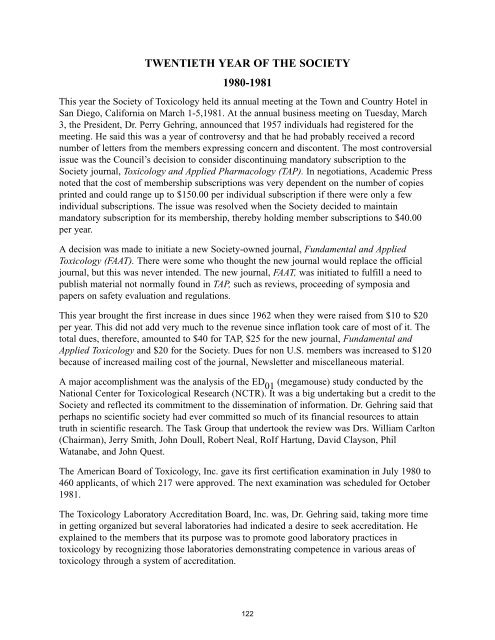SOCIETY O. TOXICOLOGY HISTORY - Society of Toxicology
SOCIETY O. TOXICOLOGY HISTORY - Society of Toxicology
SOCIETY O. TOXICOLOGY HISTORY - Society of Toxicology
Create successful ePaper yourself
Turn your PDF publications into a flip-book with our unique Google optimized e-Paper software.
TWENTIETH YEAR OF THE <strong>SOCIETY</strong><br />
1980-1981<br />
This year the <strong>Society</strong> <strong>of</strong> <strong>Toxicology</strong> held its annual meeting at the Town and Country Hotel in<br />
San Diego, California on March 1-5,1981. At the annual business meeting on Tuesday, March<br />
3, the President, Dr. Perry Gehring, announced that 1957 individuals had registered for the<br />
meeting. He said this was a year <strong>of</strong> controversy and that he had probably received a record<br />
number <strong>of</strong> letters from the members expressing concern and discontent. The most controversial<br />
issue was the Council’s decision to consider discontinuing mandatory subscription to the<br />
<strong>Society</strong> journal, <strong>Toxicology</strong> and Applied Pharmacology (TAP). In negotiations, Academic Press<br />
noted that the cost <strong>of</strong> membership subscriptions was very dependent on the number <strong>of</strong> copies<br />
printed and could range up to $150.00 per individual subscription if there were only a few<br />
individual subscriptions. The issue was resolved when the <strong>Society</strong> decided to maintain<br />
mandatory subscription for its membership, thereby holding member subscriptions to $40.00<br />
per year.<br />
A decision was made to initiate a new <strong>Society</strong>-owned journal, Fundamental and Applied<br />
<strong>Toxicology</strong> (FAAT). There were some who thought the new journal would replace the <strong>of</strong>ficial<br />
journal, but this was never intended. The new journal, FAAT, was initiated to fulfill a need to<br />
publish material not normally found in TAP, such as reviews, proceeding <strong>of</strong> symposia and<br />
papers on safety evaluation and regulations.<br />
This year brought the first increase in dues since 1962 when they were raised from $10 to $20<br />
per year. This did not add very much to the revenue since inflation took care <strong>of</strong> most <strong>of</strong> it. The<br />
total dues, therefore, amounted to $40 for TAP, $25 for the new journal, Fundamental and<br />
Applied <strong>Toxicology</strong> and $20 for the <strong>Society</strong>. Dues for non U.S. members was increased to $120<br />
because <strong>of</strong> increased mailing cost <strong>of</strong> the journal, Newsletter and miscellaneous material.<br />
A major accomplishment was the analysis <strong>of</strong> the ED 01<br />
(megamouse) study conducted by the<br />
National Center for Toxicological Research (NCTR). It was a big undertaking but a credit to the<br />
<strong>Society</strong> and reflected its commitment to the dissemination <strong>of</strong> information. Dr. Gehring said that<br />
perhaps no scientific society had ever committed so much <strong>of</strong> its financial resources to attain<br />
truth in scientific research. The Task Group that undertook the review was Drs. William Carlton<br />
(Chairman), Jerry Smith, John Doull, Robert Neal, RoIf Hartung, David Clayson, Phil<br />
Watanabe, and John Quest.<br />
The American Board <strong>of</strong> <strong>Toxicology</strong>, Inc. gave its first certification examination in July 1980 to<br />
460 applicants, <strong>of</strong> which 217 were approved. The next examination was scheduled for October<br />
1981.<br />
The <strong>Toxicology</strong> Laboratory Accreditation Board, Inc. was, Dr. Gehring said, taking more time<br />
in getting organized but several laboratories had indicated a desire to seek accreditation. He<br />
explained to the members that its purpose was to promote good laboratory practices in<br />
toxicology by recognizing those laboratories demonstrating competence in various areas <strong>of</strong><br />
toxicology through a system <strong>of</strong> accreditation.<br />
122
















